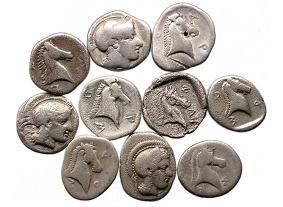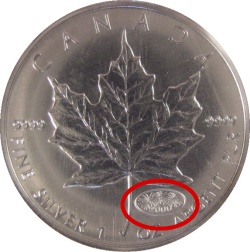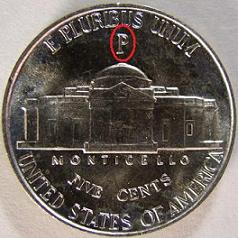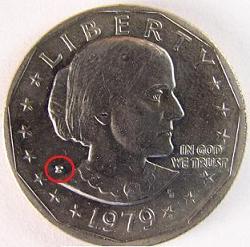The Use of Mint Marks
The use of mint marks on coins dates all the way back to the ancient Greeks. They called them "Magistrate Marks" because they referred to the magistrate in charge of producing that coin.

|
If there was a problem with a coin, they would know which magistrate was in charge of its production. Some common problems at the time could have been a coin being overweight or underweight.
This use of mint marks was also a way of keeping a check on magistrates who weren't honest. For example, a dishonest magistrate might debaseDebase
lower the amount of gold or silver that is supposed to be in the coin and replace it with an alloy or metal of much lower value a coin.

|
One example of the use of mint marks is the Privy Marks used by many mints of the world.
A privy mark is a symbol used on a coin that is unique to a specific mint.
For example, the fireworks privy mark used by the Royal Canadian Mint pictured here.
Another example is the Monnaie de Paris which uses a different privy mark for each branch mint. They include a torch, a cornucopia and a thunderbolt.
The Use of Mint Marks
on United States Coins
In early United States coin production (1793 to 1838) there were not any identifying marks simply because there was only one mint. It was located at Philadelphia, PA. Since there was only one mint, an identification mark wasn't necessary as all coins produced were coming from the same place.
In 1835, three Branch Mints were authorized and were located in Charlotte, N.C.; Dahlonega, Ga.; and New Orleans, La. Thus begins the use of mint marks in the United States.
Coins produced by these branch mints were given unique identifying marks to distinguish where each coin was struck. The Philadelphia mint, however, still did not use mint marks. Thus, all coins without mint marks during this period can be assumed to be from the Philadelphia mint.
All together there have been 8 different identifying marks since the United States began striking coins in 1792. You can see them here.

|
The Philadelphia Mint did not use mint marks until 1979 except for a brief 4-year period in which a "P" mark was used on Jefferson, Wartime 5-cent coins (1942-1945).
The reason they put a mint mark on these coins was because they were made of a silver alloy instead of the regular copper-nickel usually used in 5-cent coins.
At the time nickel was valuable war material so these nickels were made without nickel.
With the use of a mint mark, they could easily tell which coins were made with the silver alloy.
Currently the Lincoln Cent is the only coin that does not show a "P" when struck at the Philadelphia mint.
There was also a brief period of time when mint marks were not used even at the branch mints. The Coinage Act of 1965 approved the dropping of mint marks from all coins. It also authorized replacing silver coins with copper-nickel clad coinageClad Coinage
Coins that have a center core of one metal and an outer layer of a different metal..
Thus, coins dated 1965 through 1967 do not have mint marks so it is impossible to tell which mint they came from.
The idea behind the change was to keep collectors from knowing which coins were made at the branch mints in smaller numbers (limited strikes). It was believed this would put a stop to coin shortages caused by collectors hoarding limited strikes.
In 1968 the Mint Marks were returned to coins. At the same time, the location of the marks was also changed from the reverse side of the coin to the obverse (front or face side) of coins. Mint marks were still not used on coins struck (produced) at the Philadelphia mint however.
In 1975, the West Point Silver Bullion Depository began producing one cent coins. These coins did not have a mint mark and are impossible to distinguish from those struck at the Philadelphia Mint.
During the mid-1970s and into the 1980s, the San Francisco Assay Office also produced some coins without mint marks.

|
This too was done to keep collectors from hoarding coins.
Once again, in 1979, there were changes made in the Mint Mark policy.
The Philadelphia Mint produced the Susan B. Anthony dollar coin and it was given the "P" mark.
In 1980, all denominations of coins except the one-cent coin struck at the Philadelphia Mint were given the "P" mark.
To commemorate the Los Angeles Olympic Games, the West Point Mint (formerly the West Point Bullion Depository) produced the 1984 $10 gold eagle coins with a new "W" mint mark.
This was the first use of mint marks on coins from the West Point Mint. Since that time the "W" mark has been used on commemorative and bullion coins.
It was also used on the 1996-W Roosevelt dime that was included in the 1996 uncirculated Mint Set commemorating the 50th anniversary of the design.
Coins produced by the West Point Mint for circulation, however, still have no mint mark.
My Recommendation!
Don't forget to visit Amazon
That way you can take all of your coin books with you where ever you go.
I love my Kindle Fire! I highly recommend them to everyone!
I know that any time I see a coin at a flea market or coin shop or anywhere else I happen to be, all I have to do is check it out in one of the many books on my Kindle Fire. That way I can refresh my memory at any time and know for certain when I am getting a good deal on any coin.
What Would You Like To Do Now?
Return From Use of Mint Marks to Mint Marks Main Page
See where the mint mark is located on US Coins.



